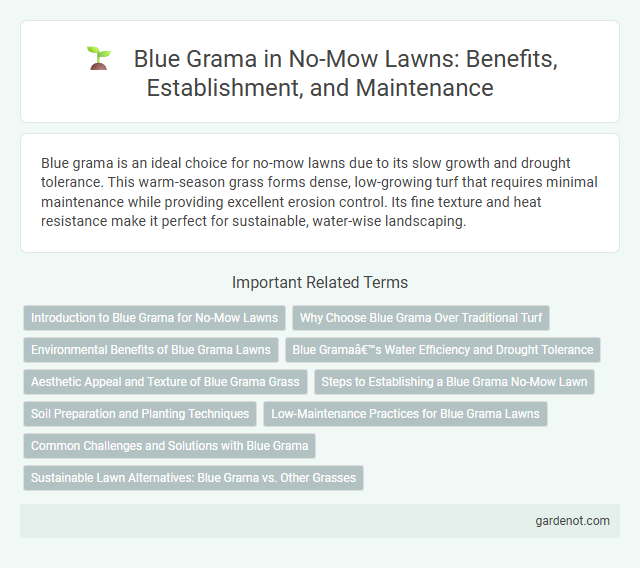Blue grama is an ideal choice for no-mow lawns due to its slow growth and drought tolerance. This warm-season grass forms dense, low-growing turf that requires minimal maintenance while providing excellent erosion control. Its fine texture and heat resistance make it perfect for sustainable, water-wise landscaping.
Introduction to Blue Grama for No-Mow Lawns
Blue grama (Bouteloua gracilis) is a drought-tolerant, warm-season grass ideal for no-mow lawns due to its low growth habit and minimal maintenance requirements. This native prairie grass thrives in full sun and well-drained soils, forming dense, fine-textured turf that reduces the need for frequent mowing and irrigation. Its heat and drought resilience make Blue grama a sustainable choice for eco-friendly landscaping in arid and semi-arid regions.
Why Choose Blue Grama Over Traditional Turf
Blue grama thrives in drought-prone regions with minimal water requirements, making it an eco-friendly alternative to traditional turf. Its deep root system enhances soil health and reduces erosion, offering long-term sustainability. This native grass requires less mowing and fertilizer, lowering maintenance costs and environmental impact.
Environmental Benefits of Blue Grama Lawns
Blue grama lawns significantly reduce water consumption compared to traditional turf grasses, thriving in drought-prone regions with minimal irrigation. Their deep root systems enhance soil stability and promote carbon sequestration, contributing to lower greenhouse gas levels. These native grasses also support local biodiversity by providing habitat and sustenance for pollinators and beneficial insects.
Blue Grama’s Water Efficiency and Drought Tolerance
Blue grama (Bouteloua gracilis) is renowned for its exceptional water efficiency, thriving with minimal irrigation due to its deep root system that accesses moisture from lower soil levels. Its drought tolerance allows it to maintain green, healthy lawns in arid and semi-arid climates, reducing the need for frequent watering. This makes blue grama an ideal choice for no-mow lawns aimed at sustainability and water conservation.
Aesthetic Appeal and Texture of Blue Grama Grass
Blue grama grass offers a unique aesthetic appeal with its fine-textured, curly seed heads that create an eye-catching, brush-like appearance. Its dense growth pattern provides a soft, plush surface that enhances the tactile experience of no-mow lawns. The bluish-green blades maintain visual interest year-round, contributing to a natural, low-maintenance landscape.
Steps to Establishing a Blue Grama No-Mow Lawn
Choose well-drained soil with full sun exposure to plant Blue Grama, a drought-tolerant native grass ideal for no-mow lawns. Prepare the site by removing existing vegetation and loosening the soil to ensure proper seed-to-soil contact, then sow Blue Grama seeds evenly at a rate of 1 to 2 pounds per 1,000 square feet. Water consistently during the germination period, maintain minimal irrigation thereafter, and avoid mowing to allow the grass to develop its natural low-growing, dense turf characteristic of a sustainable no-mow lawn.
Soil Preparation and Planting Techniques
Blue grama thrives in well-drained, sandy or loamy soils with a neutral to slightly alkaline pH range of 6.5 to 7.5, making proper soil preparation essential for optimal growth. For planting, scatter Blue grama seeds evenly over prepared soil and lightly rake to ensure good seed-to-soil contact, then water gently but consistently to maintain moisture during germination. Incorporating organic matter improves soil fertility and drainage, enhancing Blue grama establishment in no-mow lawn settings.
Low-Maintenance Practices for Blue Grama Lawns
Blue grama (Bouteloua gracilis) thrives in drought-tolerant, no-mow lawns requiring minimal watering and infrequent mowing due to its slow growth rate. Ideal maintenance includes annual light fertilization with nitrogen and mowing only once or twice per season to preserve its natural tussock form, reducing labor and equipment use. This low-maintenance grass is well-suited for sustainable landscapes where reduced water consumption and lower carbon footprints are priorities.
Common Challenges and Solutions with Blue Grama
Blue grama, a drought-tolerant native grass ideal for no-mow lawns, often faces challenges such as slow establishment and susceptibility to heavy foot traffic. Solutions include overseeding in early spring to encourage dense growth and limiting high-traffic areas to prevent thinning and soil compaction. Proper irrigation during dry spells and occasional raking to remove thatch improve vigor and maintain a healthy blue grama lawn.
Sustainable Lawn Alternatives: Blue Grama vs. Other Grasses
Blue grama (Bouteloua gracilis) offers a highly sustainable lawn alternative due to its deep root system, drought tolerance, and low maintenance requirements compared to traditional turf grasses like Kentucky bluegrass or fescue. Its ability to thrive in poor soils with minimal irrigation reduces water usage by up to 50%, making it ideal for xeriscaping and eco-friendly landscaping. Blue grama also supports local ecosystems by providing habitat for pollinators and beneficial insects, enhancing biodiversity in urban lawns.
Blue grama Infographic

 gardenot.com
gardenot.com